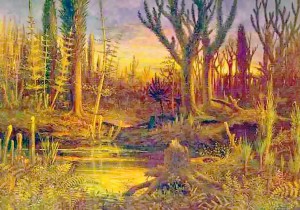Written by James Larson
Cladograms are one of the more helpful tools for biologists who need to understand how an organism has changed to become the remarkable survival  machines that they are today. My interest happens to lie in ferns, and how they thought to have first evolved in the Devonian Period about 360 million years ago. Using ferns as the focus, we can derive clear examples of the many different aspects of the cladogram and how to read it effectively.
machines that they are today. My interest happens to lie in ferns, and how they thought to have first evolved in the Devonian Period about 360 million years ago. Using ferns as the focus, we can derive clear examples of the many different aspects of the cladogram and how to read it effectively.
Before the time that ferns began to evolve as we know them, the exposed rocks of the Earth were still forming, and the soil was eerily devoid of organic nutrients. The soil was a reddish color, made up of predominantly clay, and represents an un-terraformed landscape, completely surrounded by deep blue oceans that bristled with life. Toward the beginning of the paleozoic era, during the Silurian Period, life started creeping out of the oceans. At first, there were mainly mats of photosynthetic bacteria and algae that helped add oxygen into the atmosphere and returning necessary nutrients into the soil. Then, at the beginning of the Devonian, many larger and multicellular plants began to develop, and new traits began to emerge from plants over millions of years that helped them adapt to life on land. As time went on, the Earth saw the development of bryophytes and seedless vascular plant (like ferns!) which dominated terrestrial land with their new adaptations such as seeds, leaves and new tactics for absorbing and retaining water. (Speers and Fiorillo, UCMP)
Reading a cladogram can be tricky, but also rewarding and fun once you get the hang of it! In essence, a cladogram shows you different species, and how far back in time their closest diverging point in evolutionary history. Officially, the diverging point of two species is defined as when the two species are no longer able to interbreed. For example, when the Pteridophyte phylum first developed climate specific traits beyond the seedless vascular characteristic, its characteristics had changed so much that it could no longer breed with its Sphenaphyta (Equisetum) relative. [4]
Recently, around the year 2001, a study has been carried out which showed that pteridophytes (which include ferns) and equisetophytes are monophyletic, meaning that on a cladogram their common ancestor can be shown, with all their descendants, up to the two specific phyla. (Pryer et al, 2001) This is an incredible discovery simply because it was a wonderful product of knowledge that followed innovations in the way we can track evolution of plants using recent DNA bar coding tactics.
In contrast to the monophyletic groupings, cladograms can also be thought of in polyphyletic or paraphyletic clusters. A polyphyletic clustering would be comparing 2 species that have at least one additional divergence between the modern species and when they had initially deviated, like comparing Polystichum munitum (sword fern) with Acer macrophyllum (big leaf maple).

An artist’s rendition of a scene from the Devonian Era
- A. Vasco, R. C. Moran, B. A. Ambrose, The evolution, morphology, and development of fern leaves. frontiers. 2013. 345 (September 4th, 2013) <http://www.ncbi.nlm.nih.gov/pmc/articles/PMC3761161/>
- B. R. Speer, The Devonian period. UCMP. 1995. (October 6th, 1995) <http://www.ucmp.berkeley.edu/devonian/devonian.php>
- K. M. Pryer, E. Schuettpelz, P. G. Wolf, H. Schneider, A. R. Smith, R. Cranfill Phylogeny and evolution of ferns (monilophytes) with a focus on the early leptosporangiate divergences. AJB. 91(10). 1582-1598. (2004) <http://www.botany.wisc.edu/courses/botany_940/05Frontiers/papers/9Pryer.pdf>
- K. M. Pryer, H. Schneider, A. R. Smith, R. Cranfill, P. G. Wolf, J. S. Hunt, S. D. Sipes Horsetails and ferns are a monophyletic group and the closest living relatives to seed plants. Nature. 409. 618-622 (February 1st, 2001) <http://www.nature.com/nature/journal/v409/n6820/full/409618a0.html>
- <http://www.ucmp.berkeley.edu/paleozoic/paleozoic.php>
Leave a Reply